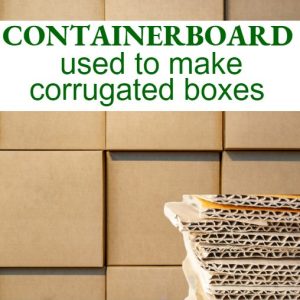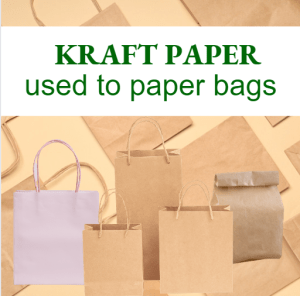In Canada, there are three major paper packaging grades:
- Containerboard (e.g., corrugated cardboard boxes),
- boxboard (e.g., cereal, cracker boxes), and
- Kraft paper (e.g., paper bags for items like groceries and paper sacks used for sugar, flour).
Each of these paper grades has its own purpose, benefits, and use, but they are all made of paper fibres and are all part of the paper packaging industry’s circular economy.
Containerboard
 Containerboard is the major packaging grade in Canada and is used to make the corrugated boxes commonly used to ship heavier products, such as appliances, electronic goods, wine, and fruit and vegetables. They are frequently used as a bulk shipper, which means they deliver many similar products in the same box.
Containerboard is the major packaging grade in Canada and is used to make the corrugated boxes commonly used to ship heavier products, such as appliances, electronic goods, wine, and fruit and vegetables. They are frequently used as a bulk shipper, which means they deliver many similar products in the same box.
Several layers of paper fibre give the corrugated box its strength:
- a top and bottom layer called linerboard
- a middle layer called corrugating medium, which is a wavy, ripple-like shape of the medium that gives the box its strength. A corrugated box always has this ripple layer (or fluting) in the middle.
Its component parts (linerboard and corrugating medium) are mostly produced from recycled content. Of the 11 containerboard mills in the country in 2020, seven produced 100% recycled content, and the balance a blend of recycled and sawmill residues or virgin fibre.
Boxboard
 Boxboard is the thin, lighter weight carton commonly used to carry a single item, such as breakfast cereal, shoes, crackers, or a toy. It does not have the wavy middle layer (corrugating medium) liked corrugated boxes. Boxboard is also used as cores and tubes, graphic board, partitions, displays, gypsum wallboard products, and children’s arts and crafts.
Boxboard is the thin, lighter weight carton commonly used to carry a single item, such as breakfast cereal, shoes, crackers, or a toy. It does not have the wavy middle layer (corrugating medium) liked corrugated boxes. Boxboard is also used as cores and tubes, graphic board, partitions, displays, gypsum wallboard products, and children’s arts and crafts.
Boxboard does not require the strong paper fibres and are mostly recycled content when it leaves the mill. It is made from a mixture of old corrugated boxes, old newspapers, used printing and writing paper and old boxboard.
Of the nine mills in Canada producing boxboard grades in 2020; seven used recycled content. One used a blend of deinked pulp and sawmill residues, and one used sawmill residues or virgin fibre and up to 25% recycled. Overall, the average recycled content for domestic shipments of boxboard is close to 80%, based on the 2020 Recycled Content Survey.
Kraft Paper
 Paper bags are made from kraft paper and are divided into two types: the paper bags used to carry groceries and/or retail items, and multi-wall sacks that contain flour and cement or are used for the collection of leaf and yard waste and organics.
Paper bags are made from kraft paper and are divided into two types: the paper bags used to carry groceries and/or retail items, and multi-wall sacks that contain flour and cement or are used for the collection of leaf and yard waste and organics.
Kraft paper is predominantly used to make multi-wall sacks and grocery bags, which require strong paper fibres.
Paper bags in Canada are made from woodchips and sawmill residues left over from lumber operations. Paper bags collected from household Blue Box recycling programs are normally recycled back into new corrugated boxes, rather than separated and shipped back thousands of kilometres to the nearest kraft paper mill for recycling. Kraft paper can be virgin material 100% recycled content, or anywhere in between.
Paper packaging plays a vital role not only in safety and convenience, but also has many environmental benefits.
Paper is made from a renewable resource from sustainably managed forests
Unlike most other packaging materials, paper packaging is originally made from a renewable resource — trees. Trees help reduce greenhouse gases in the atmosphere by acting as a giant set of lungs: inhaling the carbon dioxide that people, animals and decomposing matter produce; and exhaling oxygen which sustains all living organisms.
By law, Canadian provinces require that harvesters of the commercial forest regenerate the forest by new tree-planting and direct seeding, and natural regeneration. On average, over 1,000 new tree seedlings are planted in Canada every minute.
In addition, all PPEC-member mills producing corrugated box material have independent, third-party certification that their paper fibre sources (whether wood chips and sawmill residues or recycled fibres) are responsibly sourced.
Paper packaging uses recycled content
Most paper products manufactured in Canada are produced mainly of recycled content. In fact, the average recycled content of domestic shipments for the top two major packaging grades was 80.2%. The average has steadily increased from 47% in 1990, when PPEC first started collecting recycled content data from Canadian mills.
Canadians can recycle their paper packaging
The majority of Canadians – 94% – have access to recycling programs; and not only do they have access, they recycle their paper-based packaging, with the national recycling collection rate for corrugated boxes estimated to be 85%
Paper packaging can be recycled over and over again
Research shows that paper can be recycled up to seven times (U.S. Environmental Protection Agency), and corrugated box fibres up to ten times (Corrugated Packaging Alliance). But, paper and board fibres may be even more durable than previously thought, and we are working to better understand how many times paper fibres can be recycled in Canadian recycling systems.
The paper packaging industry is a successful circular economy
Canada’s paper packaging industry is a circular economy. The industry uses a renewable resource from sustainably managed forests, and primarily uses recycled content, which keeps valuable raw materials out of landfill, and also reduces the need to extract virgin materials. Once used by the customer, the paper packaging is recycled, and the recycled material goes back to the mill so it can be remade into new paper-based packaging. And the cycle repeats itself again and again.
Subscribe to our communications
Sign up to receive PPEC's blog and updates.
